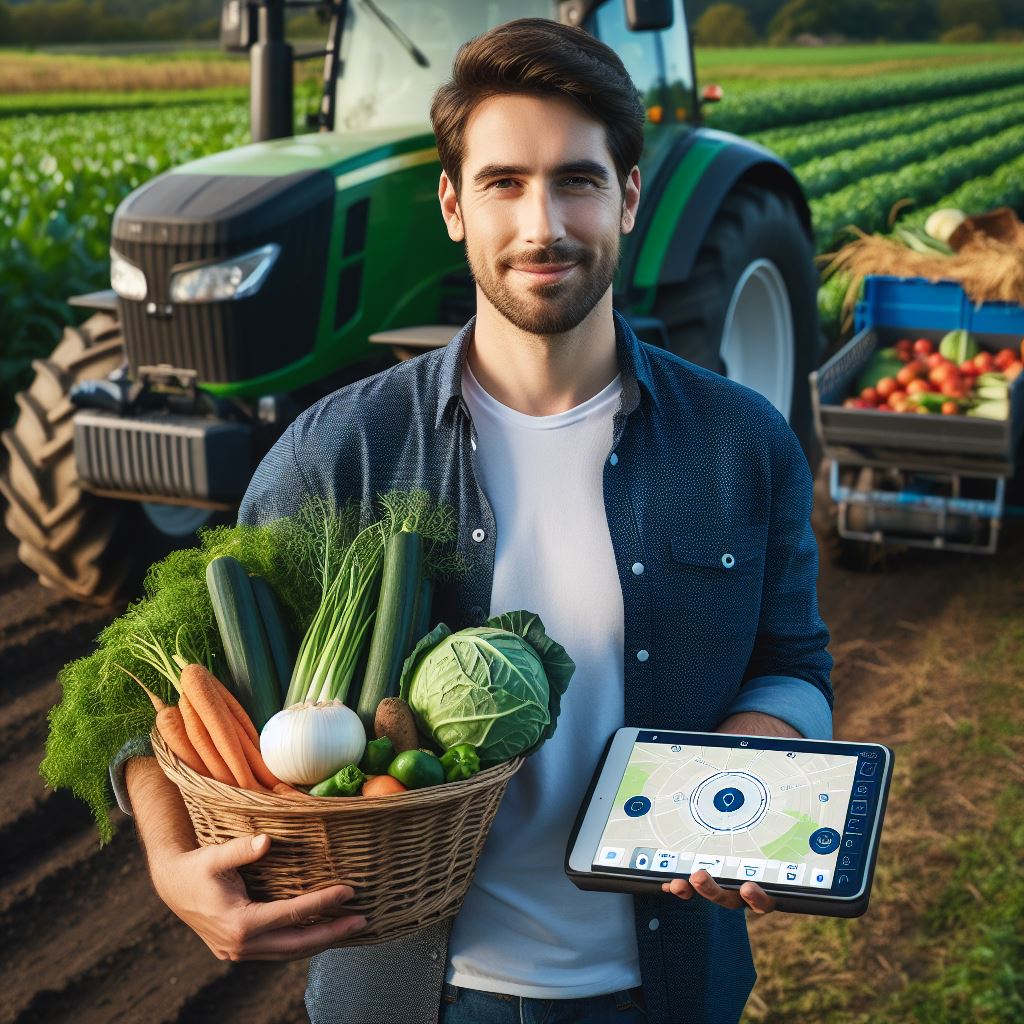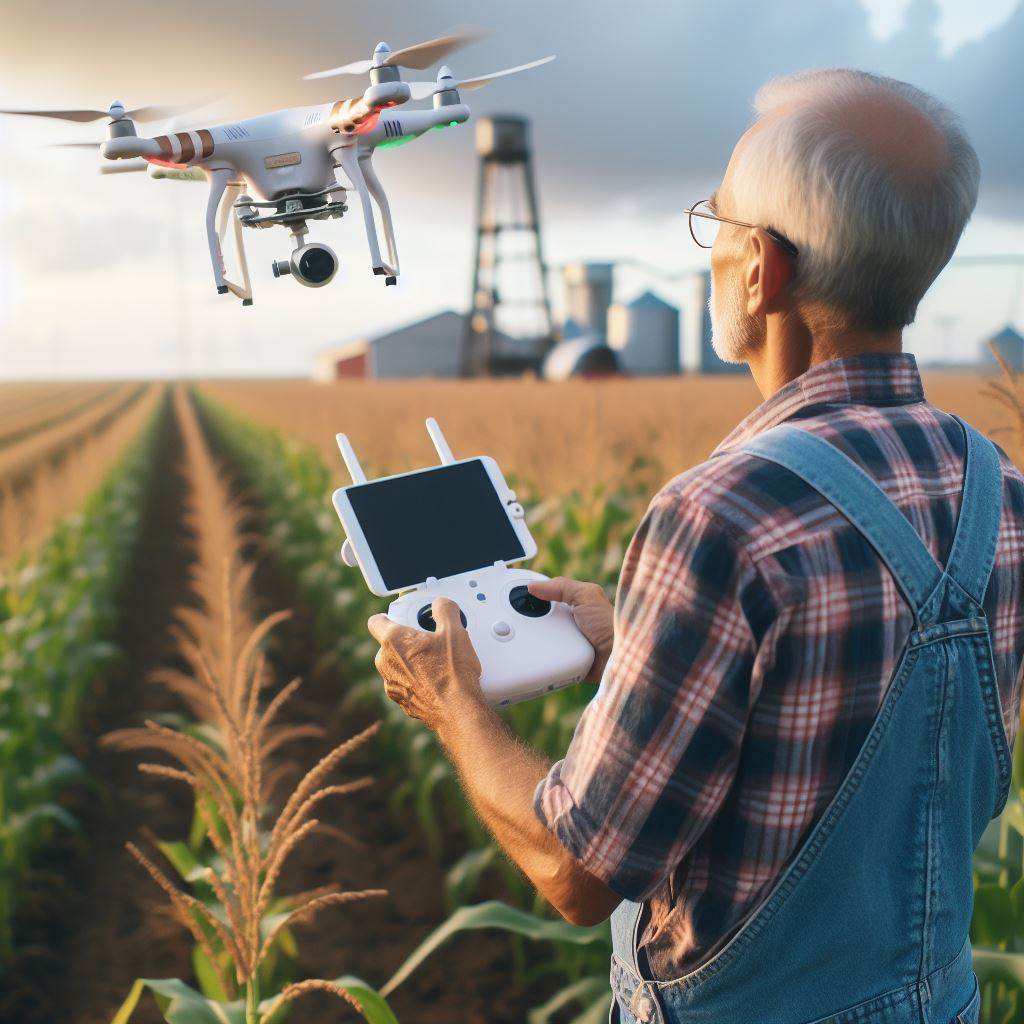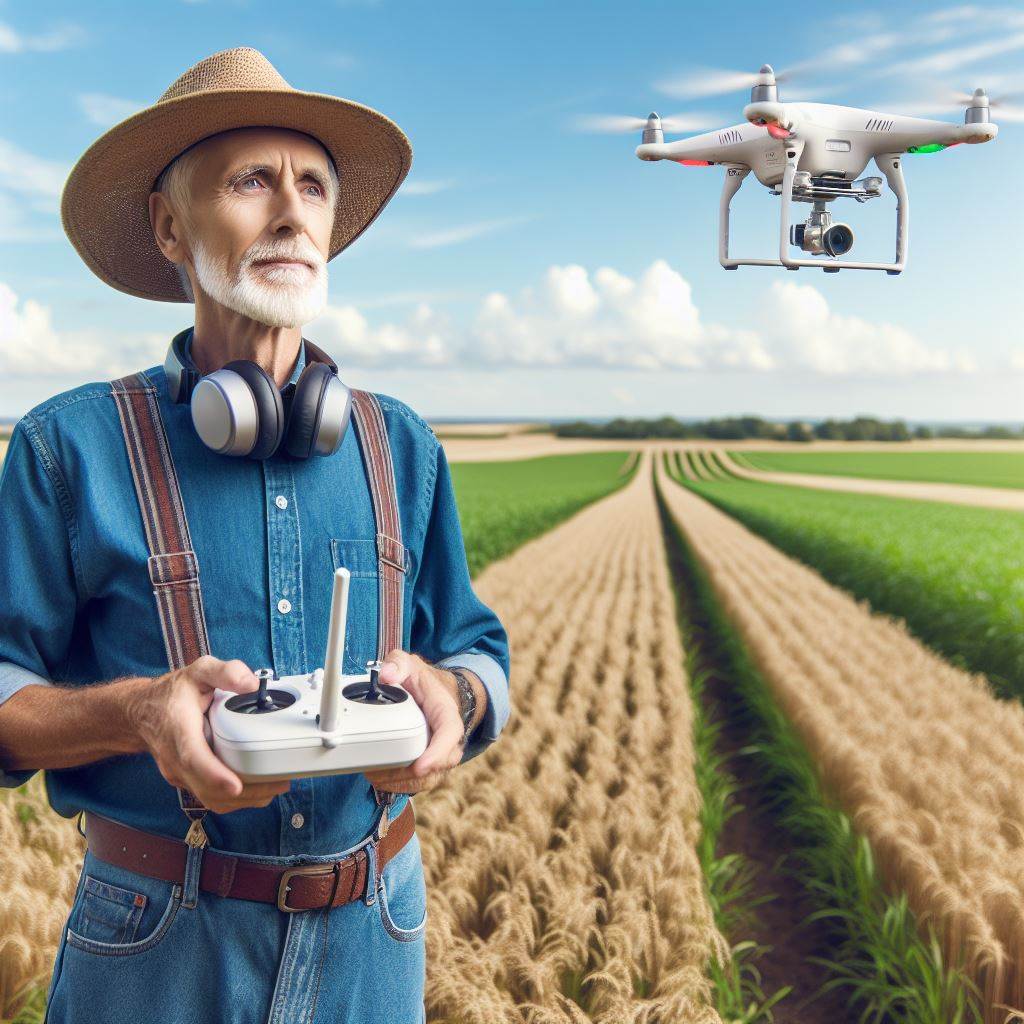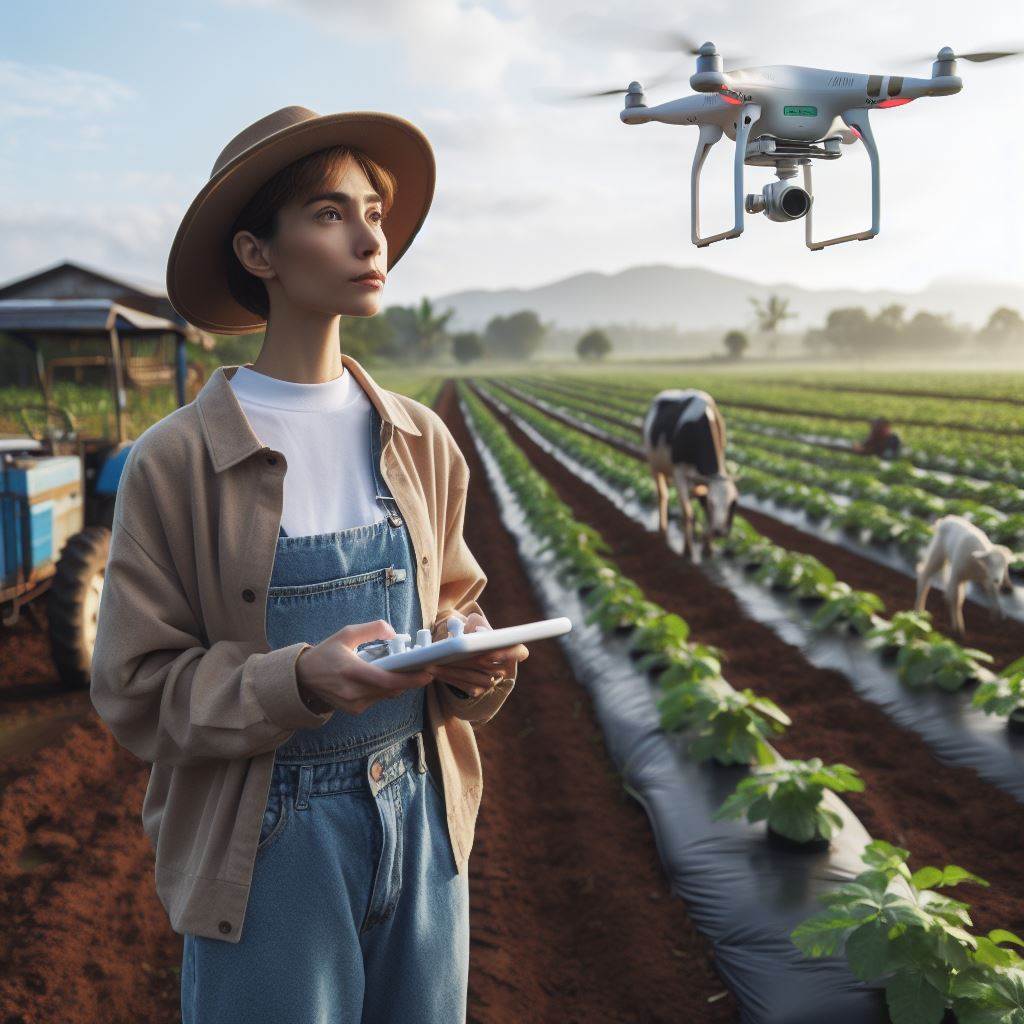Introduction
Let’s explore breakthroughs in soil health: Agri-tech role.
Soil health plays a crucial role in agriculture, as it directly impacts crop productivity and quality.
The use of technology has significantly contributed to improving soil health.
Technology in agriculture has revolutionized the way farmers manage their soil.
By utilizing advanced tools and techniques, farmers can now monitor and optimize soil conditions more effectively.
One key breakthrough in soil health is precision agriculture.
This approach integrates various technologies such as GPS, remote sensing, and data analytics to precisely manage inputs like water, fertilizers, and pesticides.
Using precision agriculture, farmers can identify specific areas of their fields that require attention, resulting in reduced resource wastage and increased crop yields.
This targeted approach helps maintain soil health by preventing overuse of inputs and minimizing environmental impacts.
Another technological advancement in soil health is the use of sensors and drones.
Soil sensors provide real-time data on moisture levels, temperature, and nutrient content, allowing farmers to make informed decisions about irrigation and fertilizer application.
Drones equipped with multispectral cameras can capture detailed images of fields, identifying variations in soil health.
This information helps farmers identify areas where soil amendments are required, promoting healthier and more productive soils.
Furthermore, data-driven platforms enable farmers to analyze soil health over time and make informed decisions regarding crop rotation, cover cropping, and other regenerative practices.
This technology-driven approach ensures sustainable soil management and supports long-term agricultural productivity.
Transform Your Agribusiness
Unlock your farm's potential with expert advice tailored to your needs. Get actionable steps that drive real results.
Get StartedIn essence, technology has played a pivotal role in improving soil health in agriculture.
Precision agriculture, sensors, drones, and data analytics have enabled farmers to optimize soil conditions, reduce resource wastage, and enhance crop yields.
Embracing agri-tech solutions is essential for sustainable soil management and the future of agriculture.
The current state of soil health
Soil is a precious resource that plays a vital role in agriculture and food production.
However, the current state of soil health is a cause for concern.
Modern agriculture faces numerous challenges in maintaining the health of the soil, while conventional farming practices often have negative impacts on soil health.
The challenges faced by modern agriculture regarding soil health
One of the major challenges faced by modern agriculture is soil erosion.
Unsustainable farming practices, such as excessive tilling and monoculture, contribute to the erosion of topsoil.
When the top layer of soil is eroded, it loses its organic matter and vital nutrients, making it less fertile and less capable of sustaining plant growth.
This eventually leads to reduced crop yields and lower agricultural productivity.
In addition to soil erosion, soil compaction is another challenge faced by modern agriculture.
Heavy machinery used in conventional farming practices can compact the soil, reducing its ability to absorb water and air.
Compacted soil can hinder root growth and restrict nutrient uptake by plants, further compromising soil health and agricultural productivity.
Chemical-intensive agriculture is also detrimental to soil health.
The excessive use of synthetic fertilizers and pesticides not only harms beneficial organisms in the soil but also disrupts the natural balance of soil microorganisms.
This imbalance can lead to the degradation of soil structure, decrease in organic matter content, and the loss of important soil functions such as nutrient cycling and water retention.
The negative impacts of conventional farming practices on soil health
- Moreover, the reliance on chemical inputs in conventional farming practices can result in soil contamination.
- Synthetic fertilizers and pesticides can leach into groundwater, leading to water pollution and posing risks to human health.
- These chemical inputs can also accumulate in the soil over time, resulting in long-term soil degradation and reducing its capacity to support sustainable agricultural practices.
- Conventional farming practices also contribute to the loss of biodiversity in soil.
- The use of monocultures and the elimination of natural habitats and vegetation strips reduce the diversity of soil organisms, including beneficial microbes, earthworms, and insects.
- This loss of biodiversity has a direct impact on soil health, as diverse soil communities play crucial roles in nutrient cycling, organic matter decomposition, and maintaining soil structure.
- To address these challenges and improve soil health, agri-tech has a significant role to play.
- Innovative technologies can help mitigate soil erosion by promoting conservation practices such as agroforestry, where trees are planted alongside crops to prevent erosion and improve soil structure.
- Precision agriculture techniques utilizing advanced sensors and data analytics can enable farmers to optimize fertilizer and water use, reducing chemical inputs and minimizing soil contamination.
- Furthermore, agri-tech solutions can promote sustainable practices like crop rotation and cover cropping, which enhance soil fertility and biodiversity.
- These practices help maintain a healthy balance of nutrients in the soil and support beneficial soil organisms, improving soil structure and nutrient cycling.
In short, the current state of soil health poses significant challenges to modern agriculture, with conventional farming practices having negative impacts on soil health.
Soil erosion, compaction, chemical contamination, and loss of biodiversity are some of the key issues that need to be addressed.
However, through the integration of agri-tech solutions, such as precision agriculture and sustainable practices, we can improve soil health and ensure a more sustainable future for agriculture.
Investing in research and development of agri-tech is crucial to not only protect the soil but also to safeguard food security and promote environmental sustainability.
Read: Sustainable Farming: How Agri-Tech is Helping
Overview of agri-tech’s role in soil health
How technological advancements have revolutionized the agricultural industry
The agricultural industry has undergone a remarkable transformation in recent years, thanks to significant technological advancements.
Agri-tech, the application of technology in agriculture, has played a crucial role in this revolution.
One area where agri-tech has made a profound impact is soil health.
Showcase Your Farming Business
Publish your professional farming services profile on our blog for a one-time fee of $200 and reach a dedicated audience of farmers and agribusiness owners.
Publish Your ProfileBy leveraging innovative tools and techniques, agri-tech has contributed to the improvement of soil health in several specific ways.
The specific areas where agri-tech has contributed to improving soil health
Enhanced data collection and analysis
Agri-tech has revolutionized data collection and analysis in agriculture.
Through the use of sensors, drones, and satellites, farmers can gather precise and real-time data on soil conditions.
This data includes moisture levels, pH levels, nutrient composition, and even the presence of pests or diseases.
By analyzing this data, farmers can make informed decisions about soil management practices.
Precision agriculture techniques
Precision agriculture techniques have been made possible by agri-tech.
With the help of GPS technology and specialized machinery, farmers can precisely apply fertilizers, pesticides, and water to their fields.
This precise application ensures that nutrients are delivered only where needed, minimizing wastage and reducing the risk of soil contamination.
Precision agriculture also enables farmers to tailor soil management practices to specific areas of their fields, optimizing soil health.
Smart irrigation systems
Agri-tech has introduced smart irrigation systems that help conserve water and promote soil health.
These systems use sensors to monitor soil moisture levels and weather conditions in real-time.
Based on this data, they automatically adjust the irrigation schedule and the amount of water distributed.
This ensures that crops receive adequate water without over-watering, preventing soil erosion and nutrient leaching.
Soil mapping and monitoring
Through agri-tech, farmers can now create detailed soil maps and regularly monitor soil health.
Soil sensors and scanning technologies allow for the collection of comprehensive data on soil composition, structure, and fertility.
By understanding the variations in soil characteristics across their fields, farmers can implement targeted soil management strategies.
This includes the application of specific amendments or the adoption of conservation practices to address potential issues.
Biological and organic solutions
Agri-tech has also played a crucial role in the development and implementation of biological and organic solutions for soil health.
By utilizing advanced biological products, such as biofertilizers and biopesticides, farmers can enhance soil fertility and combat pests and diseases in an environmentally friendly manner.
These innovative solutions harness the power of beneficial microorganisms and natural compounds, reducing the reliance on synthetic inputs.
Data-driven decision-making
One of the most significant contributions of agri-tech to soil health is the facilitation of data-driven decision-making.
By integrating all the data collected through various agri-tech tools, farmers can gain a holistic understanding of their soil health.
This comprehensive knowledge empowers them to make informed choices about crop selection, soil management practices, and the implementation of sustainable farming techniques.
It enables farmers to optimize yields while preserving and enhancing soil health for future generations.
In summary, agri-tech has truly revolutionized the agricultural industry, and its impact on soil health cannot be underestimated.
Through enhanced data collection and analysis, precision agriculture techniques, smart irrigation systems, soil mapping, and monitoring, as well as the development of biological and organic solutions, agri-tech has significantly contributed to improving soil health.
By embracing agri-tech, farmers can better understand their soils, adopt sustainable practices, and ensure the long-term productivity of their farms.
Read: Innovative Agri-Tech: Drones Changing Agriculture
Precision agriculture and soil health
Precision agriculture techniques have revolutionized the field of soil health, offering innovative solutions to optimize soil conditions.
By incorporating advanced technologies such as remote sensing, GPS, and data analytics, farmers can now enhance their understanding of soil health and implement targeted interventions.
This section will delve into the use of precision agriculture in optimizing soil health and its associated benefits, specifically focusing on reducing soil erosion and nutrient depletion.
The use of precision agriculture techniques in optimizing soil health
- Remote sensing technologies enable farmers to assess soil conditions accurately, ensuring timely interventions to improve soil health.
- By analyzing data gathered through remote sensing, farmers can identify areas with low soil fertility and apply specific treatments, minimizing nutrient wastage.
- Precision agriculture techniques such as variable rate application allow for the precise delivery of fertilizers and pesticides, reducing the risk of over-application and minimizing soil erosion.
- Soil erosion, caused by factors like wind and water, can have detrimental effects on agricultural productivity.
Precision agriculture techniques mitigate erosion by optimizing land management practices. - Utilizing GPS technology, farmers can accurately map the boundaries and topography of their fields, designing appropriate irrigation systems to prevent water-induced erosion.
- Precision agriculture also aids in reducing nutrient depletion by utilizing sensors to monitor nutrient levels in the soil, enabling farmers to apply fertilizers precisely where they are needed.
- This targeted approach minimizes excessive fertilizer usage, preventing nutrient runoff and subsequent pollution of water bodies.
- By optimizing soil health through precision agriculture, farmers can improve crop yields and quality, ensuring sustainable agricultural practices.
The benefits of precision agriculture in reducing soil erosion and nutrient depletion
- The benefits of precision agriculture extend beyond the farm level.
Enhanced soil health leads to better water quality and reduced environmental impact, benefiting the broader ecosystem. - Precision agriculture techniques also contribute to reducing greenhouse gas emissions by optimizing nutrient applications and minimizing waste.
- Additionally, precision agriculture enhances resource efficiency by utilizing inputs more effectively, thereby reducing operational costs for farmers.
- The integration of precision agriculture techniques with soil health monitoring enables farmers to make informed decisions and implement targeted interventions.
- Data analytics platforms provide farmers with valuable insights into soil health trends, facilitating proactive measures to address potential issues.
- Collaborative efforts between farmers, researchers, and agricultural technology companies are crucial in further advancing precision agriculture’s role in soil health optimization.
- Research and development in precision agriculture continue to drive innovation, with the potential for even more breakthroughs in the future.
In closing, precision agriculture plays a pivotal role in optimizing soil health.
Through the use of advanced technologies, farmers can address soil erosion and nutrient depletion more effectively, leading to improved crop productivity, resource efficiency, and environmental sustainability.
By harnessing the power of precision agriculture, we can pave the way for a more resilient and prosperous agricultural sector.
Read: Agri-Tech and Big Data: Transforming Farm Management
Utilization of digital tools in soil health management
Soil health plays a crucial role in the success of agriculture, and advancements in agri-tech have revolutionized soil health management.
In recent years, the utilization of digital tools and sensors has gained significant importance in monitoring soil conditions.
The use of digital tools and sensors in monitoring soil conditions
Traditionally, farmers used to rely solely on manual observations and experience to assess soil health.
However, these methods were subjective, time-consuming, and often lacked accuracy.
With the advent of digital tools, farmers now have access to real-time data and insights, enabling them to make more informed decisions.
Showcase Your Farming Business
Publish your professional farming services profile on our blog for a one-time fee of $200 and reach a dedicated audience of farmers and agribusiness owners.
Publish Your ProfileDigital tools such as soil sensors and remote sensing technology provide detailed information about various soil parameters.
These sensors can measure key indicators like moisture content, temperature, pH levels, and nutrient levels in the soil.
The data collected by these sensors is then transmitted wirelessly to a central monitoring system.
This real-time data allows farmers to monitor soil health conditions round the clock.
They can identify potential issues such as nutrient deficiencies or excesses, moisture imbalances, and soil degradation.
By having access to this information, farmers can take immediate actions to rectify any problems and ensure optimal soil health.
How these tools assist in maintaining proper soil health and fertility
- One of the significant benefits of using digital tools in soil health management is the ability to maintain proper soil fertility.
- By continuously monitoring nutrient levels, farmers can apply fertilizers precisely when and where they are needed.
- This precision application not only optimizes crop growth but also minimizes the overuse of fertilizers.
- Using digital tools also helps in reducing water wastage by providing accurate soil moisture data.
- Farmers can schedule irrigation based on actual soil moisture content, preventing both under and over watering.
- This leads to more efficient water usage and conservation.
- Additionally, digital tools provide historical data and trends, which can be used for long-term planning and decision-making.
- Farmers can analyze the data to understand how soil health is affected by crop rotation, tillage practices, or the use of specific fertilizers.
- This knowledge can help in making informed choices for sustainable farming practices.
- Furthermore, digital tools can assist in predicting soil health outcomes.
- By analyzing the collected data, predictive models can be developed to anticipate potential soil issues or diseases.
- Farmers can take preventive measures in advance, minimizing the impact on crop yield and overall productivity.
- The integration of digital tools in soil health management also promotes precision agriculture.
- With the use of GPS and satellite imagery, farmers can map soil variability within their fields.
- This allows for variable rate applications of inputs such as fertilizers and pesticides, optimizing resource utilization and reducing environmental impact.
In general, the utilization of digital tools and sensors in soil health management has revolutionized agriculture.
These tools provide real-time data, enabling farmers to make informed decisions, maintain optimal soil health, and enhance overall productivity.
By embracing agri-tech advancements, farmers can ensure sustainable and efficient farming practices for the future.
Read: Future of Farming: AI and Machine Learning in Agri-Tech

Advancements in Soil Testing and Analysis: The Key to Improving Agriculture
Soil health is a critical factor in the success of agriculture, and accurate soil testing and analysis play a pivotal role in understanding and improving its condition.
Over the years, significant advancements have taken place in soil testing methods and equipment, revolutionizing the way farmers manage their land.
In this blog section, we will explore the importance of accurate soil testing and delve into the breakthrough technologies that have transformed this crucial aspect of agriculture.
Importance of Accurate Soil Testing and Analysis
Accurate soil testing is essential as it provides farmers with crucial information about the fertility, nutrient content, and overall health of their soil.
By understanding the soil’s characteristics, farmers can make informed decisions regarding the amount and type of fertilizers, pesticides, and irrigation methods required for optimal crop growth.
It helps them tailor their approach to specific soil requirements, leading to better yields, reduced costs, and minimal environmental impact.
Technological Breakthroughs in Soil Testing Methods and Equipment
- Remote Sensing and GIS Mapping: Remote sensing technologies, such as satellites and aerial imagery, have revolutionized soil testing. They provide accurate data on soil moisture, temperature, and nutrient levels on a large scale, enabling farmers to identify variations within their fields. Coupled with Geographic Information System (GIS) mapping, these technologies offer precise and detailed soil fertility maps, facilitating targeted management practices.
- Portable Soil Testing Devices: Traditional soil testing methods were time-consuming and required sending samples to a lab for analysis. However, portable soil testing devices have emerged, empowering farmers to conduct on-site analysis and obtain immediate results. These handheld devices measure parameters like pH, nitrogen, phosphorus, and potassium levels, enabling farmers to make real-time adjustments to their nutrient management strategies.
- DNA Sequencing: DNA sequencing techniques have found their way into soil testing, allowing for a comprehensive analysis of the microbial communities present in the soil. By understanding the soil microbiome, farmers can assess the soil’s health and its potential to support crop growth. This breakthrough technology helps determine the need for soil amendments and aids in the development of tailored strategies for pest and disease management.
- Big Data and Machine Learning: The integration of big data and machine learning algorithms has greatly enhanced soil testing and analysis. By harnessing vast amounts of historical and real-time data, these technologies can generate predictive models that forecast soil conditions, nutrient requirements, and crop growth patterns accurately. Farmers can then optimize their management practices, reduce waste, and achieve sustainable agricultural outcomes.
- Variable Rate Technology: Variable rate technology has transformed the way farmers apply fertilizers and other inputs. By using precise equipment, such as soil sensors and GPS-guided applicators, farmers can adjust the application rates according to the specific needs of different areas within their fields. This approach ensures optimal nutrient distribution, minimizes overuse, and promotes uniform crop growth, ultimately leading to higher yields.
- Sensor-based Irrigation Systems: Water scarcity is a significant concern in agriculture. Sensor-based irrigation systems provide an efficient solution by allowing farmers to monitor soil moisture levels in real-time. These sensors offer accurate data on moisture content, enabling farmers to apply water precisely when and where required. It aids in preventing overwatering, conserving water resources, and maintaining appropriate soil moisture levels for healthy plant growth.
In a nutshell, advancements in soil testing and analysis have propelled agricultural practices towards precision and sustainability.
Accurate soil testing provides farmers with the necessary insights to optimize nutrient management, reduce costs, and enhance crop productivity.
Breakthrough technologies, such as remote sensing, portable devices, DNA sequencing, big data analytics, variable rate technology, and sensor-based irrigation, have revolutionized soil testing methods and equipment.
By embracing these innovations, farmers can unlock the potential of their land and contribute to a more prosperous and sustainable agricultural sector.
Gain More Insights: Yield Boosting: Robotics in Action
Biological farming and soil health
Biological farming practices have gained attention for their potential in enhancing soil health.
By incorporating natural processes and beneficial microorganisms, these practices can improve soil fertility and sustainability.
Here, we will explore the implementation of biological farming practices and the role of beneficial microorganisms and cover crops in improving soil health.
Implementation of biological farming practices
- Transitioning from conventional to biological farming methods requires a holistic approach.
- Farmers must focus on soil health by minimizing chemical inputs and maximizing natural processes.
- Implementing crop rotation, cover cropping, and composting are essential practices in biological farming.
- Crop rotation helps break pest cycles and promotes nutrient cycling, reducing the need for pesticides and fertilizers.
- Cover crops, such as legumes and grasses, improve soil structure, prevent erosion, and enhance nutrient availability.
- Composting organic waste can provide valuable nutrients and beneficial microorganisms to enrich the soil.
Role of beneficial microorganisms in improving soil fertility
- Beneficial microorganisms form a crucial component of a healthy soil ecosystem.
- They contribute to nutrient cycling, disease suppression, and overall soil structure improvement.
- Microorganisms like mycorrhizal fungi form symbiotic relationships with plants, enhancing nutrient uptake.
- Nitrogen-fixing bacteria, such as Rhizobia, convert atmospheric nitrogen into plant-usable forms.
- Bacteria and fungi decompose organic matter, releasing nutrients and improving soil structure.
Role of cover crops in improving soil fertility
- Cover crops help maintain soil health during periods when the main crops are not actively growing.
- They protect the soil from erosion, weed growth, and nutrient leaching.
- Legume cover crops are particularly valuable as they can fix atmospheric nitrogen.
- Cover crops also improve soil structure by adding organic matter and enhancing water infiltration.
- When terminated or incorporated into the soil, cover crops contribute essential nutrients.
In Ultimately, biological farming practices have shown significant potential in enhancing soil health and sustainability.
By implementing practices like crop rotation, cover cropping, and composting, farmers can minimize chemical inputs and maximize natural processes.
Beneficial microorganisms play a crucial role in nutrient cycling and soil structure improvement, while cover crops protect the soil and enhance fertility.
Embracing these practices can lead to healthier and more productive agricultural systems, ensuring long-term soil health and food security.
Emerging trends in soil health monitoring
The latest trends in soil health monitoring and data collection
- Adoption of advanced sensor technology: Soil health monitoring is witnessing a shift towards the use of advanced sensor technology.
These sensors provide real-time data on soil moisture, temperature, and nutrient levels. - Remote sensing techniques: Remote sensing techniques, such as satellite imagery and aerial drones, are increasingly being employed to monitor soil health.
These techniques provide a comprehensive view of large agricultural areas and can detect variations in soil properties. - Internet of Things (IoT) integration: IoT devices, such as wireless soil moisture sensors, are becoming more prevalent in agriculture.
These devices help farmers monitor soil health parameters remotely and optimize irrigation practices. - Mobile applications for data collection: Mobile applications are being developed to simplify data collection on soil health parameters.
These apps enable farmers to record soil properties, pest and disease incidences, and crop growth stages conveniently.
The integration of artificial intelligence and machine learning in soil health analysis
- Integration of artificial intelligence (AI) and machine learning (ML): AI and ML algorithms are being utilized to analyze the massive amounts of data collected from various soil health monitoring techniques. These algorithms can identify patterns and trends that humans may overlook.
- Predictive modeling for soil health analysis: AI and ML algorithms are also applied to develop predictive models for soil health analysis. These models can forecast soil nutrient levels, pest outbreaks, and crop yields, aiding in decision-making processes.
- Blockchain for data transparency: Blockchain technology is being explored to ensure transparency and traceability in soil health data. By recording every transaction or change in soil health data on a decentralized ledger, stakeholders can trust the accuracy and integrity of the information.
- Collaborative platforms for data sharing: Organizations are creating collaborative platforms where farmers, researchers, and policymakers can share soil health data. This data sharing facilitates collective learning, as stakeholders can access a wide range of soil health information.
- Integration with precision farming: Soil health monitoring is being integrated with precision farming practices. This enables farmers to apply inputs, such as fertilizers and water, in a targeted manner, based on the specific soil health needs of different areas within their fields.
- Adoption of regenerative agriculture practices: Regenerative agriculture practices focus on improving soil health through practices like cover cropping and crop rotation. Soil health monitoring plays a crucial role in assessing the effectiveness of these practices and guiding their implementation.
- Emphasis on organic farming: Organic farming relies on soil health to improve crop productivity and reduce the dependence on synthetic inputs. Soil health monitoring allows organic farmers to track the impact of their practices on soil fertility and make informed decisions.
- Citizen science initiatives: Citizen science initiatives involve engaging farmers and the general public in soil health monitoring.
By collecting data from a wide network of participants, these initiatives contribute to a more comprehensive understanding of soil health trends at a larger scale. - Automation of data analysis: Automated data analysis tools are being developed to streamline the process of soil health analysis. These tools can quickly process large datasets and generate actionable insights for farmers and researchers.
- Integration with farm management systems: Soil health monitoring is being integrated with farm management systems, enabling farmers to monitor soil health alongside other operational parameters. This integration allows for more holistic decision-making and resource allocation on farms.
- Increased focus on soil biodiversity: Soil health monitoring is now expanding beyond traditional physical and chemical indicators to include the assessment of soil biodiversity. Understanding and promoting soil biodiversity can improve overall soil health and ecosystem resilience.
Incorporating these emerging trends in soil health monitoring and data collection can revolutionize agricultural practices.
The integration of advanced technologies, such as AI, ML, and IoT, offers new opportunities to maximize productivity while ensuring sustainable soil management for future generations.
Conclusion
Soil health plays a vital role in agriculture, as it directly impacts crop productivity and sustainability.
Agri-tech has emerged as a crucial factor in advancing soil health and promoting environmentally-friendly farming practices.
The significance of soil health cannot be overstated in the context of agriculture.
Healthy soils lead to increased yields, improved water retention, and reduced reliance on chemicals.
This is not only beneficial for farmers but also for the overall ecosystem.
Agri-tech has revolutionized the way we approach soil health.
Through innovative technologies such as sensors, drones, and precision farming techniques, farmers can monitor soil conditions, optimize irrigation and fertilization, and implement site-specific management practices.
The role of agri-tech in advancing soil health is far-reaching.
It enables farmers to make informed decisions, reduce input wastage, and enhance resource efficiency.
By leveraging technology, we can achieve sustainable agriculture that ensures long-term productivity while minimizing the negative environmental impacts.
Showcase Your Farming Business
Publish your professional farming services profile on our blog for a one-time fee of $200 and reach a dedicated audience of farmers and agribusiness owners.
Publish Your ProfileMoreover, agri-tech empowers farmers to adopt regenerative practices like cover cropping, crop rotation, and organic farming, thereby improving soil fertility and biodiversity.
These practices enrich the soil, promote natural pest control, and reduce the need for chemical interventions.
Therefore, the future of agriculture heavily relies on the utilization of cutting-edge technology to improve soil health.
Agri-tech offers immense potential to address the challenges of feeding a growing population while preserving the environment.
By embracing agri-tech, we can pave the way for a sustainable and prosperous agricultural sector.




